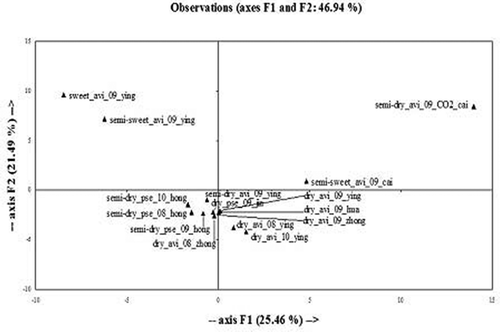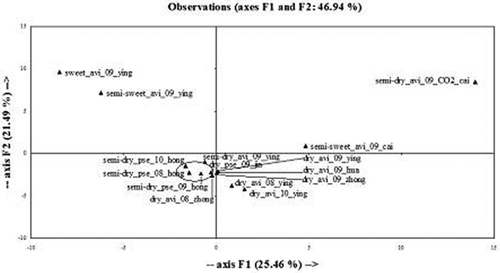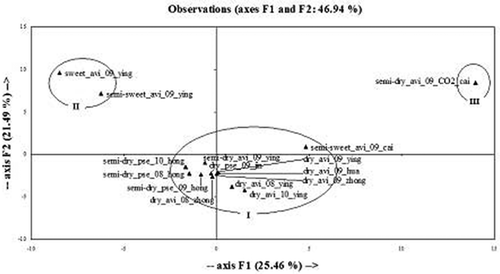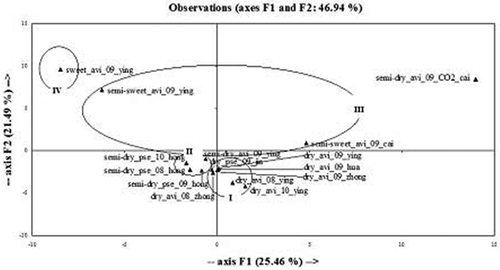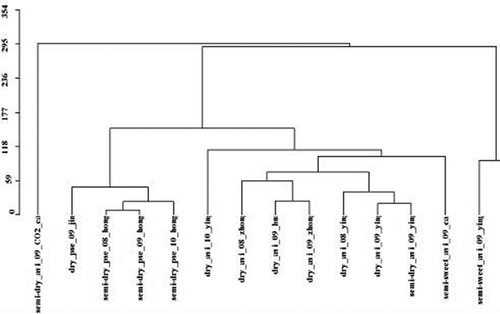Abstract
Headspace solid phase microextraction and gas chromatography-mass spectrometry was applied for cherry wine volatile analysis. Multivariate statistical analyses were used to track the influence of cultivar, fermentation method, wine type, vintage, and origin on the aroma of cherry wine. The major compounds in cherry wines are isoamylol, ethyl acetate, benzyl alcohol, benzaldehyde, and diethyl succinate. The principal component analysis results showed that classifying cherry wines by gas chromatography-mass spectrometry was highly related to fermentation methods and wine types. The agglomerative hierarchical clustering result indicated fermentation method has a greater effect on classification of cherry wines than other factors.
INTRODUCTION
Cherry products have recently attracted substantial interest because of their beneficial healthy effects, such as strong antioxidant activities, neuroprotective effects, and potent cancer-preventive properties.[Citation1] Cherry wine has a unique color and flavor. It is becoming more popular in China. The main cultivars of cherry in China are sweet cherry (Prunus avium L.), sour cherry (Prunus cerasus L.), Chinese cherry (Prunus pseudocerasus L.), and Prunus tomentosa Thumb. Attributing to the high sugar level and high edible rate, P. avium L. (Hongdeng, Van, Lapins, Hongyan, Hongfeng, Changbahong, etc.) and P. pseudocerasus L. (Laiyang Short, Zhuji Short-Petíole, etc.) are the two species extensively used in the cherry wine industry of China. The main producing areas in China are Shandong province, Jiangsu province, and Sichuan province. The traditional fermentation method is commonly used. Carbonic maceration is a new winemaking technique, in which whole cherries are fermented in a carbon dioxide-rich environment prior to crushing. Cold maceration is to freeze cherries before crushing.
Meticulous and continuous controls are required to maintain the authenticity of wine, mainly in terms of vintage, variety, and geographical origin. Most of the compounds in wines, such as amino acids,[Citation2] trace elements,[Citation3] organic acids,[Citation4] phenols,[Citation4,Citation5] and volatile compounds,[Citation6,Citation7] were investigated for this purpose. Aroma is a fundamental organoleptic parameter in the quality assessment of wines, as it contributes to the organoleptic characteristic, flavor, and typicality of final products.[Citation8,Citation9] The investigation of volatile compounds may also be considered as a strategy to ensure the authenticity of wine, because the flavor of wine depends on the raw materials, the constituents formed during the fermentation and the substances formed during aging. Several researchers have already used volatile profiles to differentiate wines according to vintage, variety, and geographical origin. Garde-Cerdán and colleagues[Citation10] differentiated Spanish wines according to their origin, variety, and storage time. Berna et al.[Citation11] classified Sauvignon Blanc wine samples from three different countries and six regions. However, relatively little attention has been focused on the classification of cherry wines based on different influencing factors, such as cherry cultivar, fermentation method, wine type, vintage, and origin.
The volatile profiles of cherry from different cultivars have been studied extensively.[Citation12CitationCitationCitationCitationCitation–Citation18] These researches showed that (E)-2-hexenol, benzaldehyde, hexanal, and (E)-2-hexenal were the most important volatiles of sweet cherry, while benzaldehyde, benzyl alcohol, eugenol, and vanillin were the important volatiles of sour cherry. For cherry wine, Sun and colleagues[Citation19] conducted research on the effect of Saccharomyces cerevisiae strains on the flavor profiles. Acetic acid, 3-methylbutanol, 2-methylpropanol, and ethyl lactate were found in the highest concentrations among all the identified volatile compounds determined by solid phase microextraction and gas chromatography-mass spectrometry (SPME/GC-MS). Niu et al.[Citation20] characterized odor-active compounds of various cherry wines by GC-MS, gas chromatography-olfactometry (GC-O) and their correlation with sensory attributes. Twenty-four odor-active compounds were selected as specific compounds correlated to sensory attributes: ethyl 2-methyl propionate, 2,3-butanedione, ethyl butyrate, ethyl pentanoate, 3-methyl-1-butanol, ethyl hexanoate, 3-hydroxy-2-butanone, ethyl lactate, 1-hexanol, (Z)-3-hexen-1-ol, ethyl hydroxyacetate, acetic acid, furfural, 2-ethyl-1-hexanol, benzaldehyde, propanoic acid, butanoic acid, guaiacol, beta-citronellol, hexanoic acid, 2-methoxy-4-methylphenol, 2-ethyl-3-hydroxy-4H-pyran-4-one, ethyl cinnamate, and 2-methoxy-4-vinylphenol.
In this research, the authors use headspace solid-phase microextraction (HS-SPME) technique coupled with GC-MS to analyze the volatile compounds of cherry wines, aiming to elucidate the volatile compounds of 15 commercial cherry wines from 3 vintages (2008, 2009, and 2010), 2 varieties (P. avium L. and P. pseudocerasus L.), and 2 provinces (Jiangsu province and Shandong province) in East China.
MATERIALS AND METHODS
Wine Samples
All tested cherry wines in sealed 750-mL bottles were sourced from various wineries in the East China district, mainly in Jiangsu and Shandong provinces. Details of the cherry wine samples used in this research were summarized in .
TABLE 1 Summary of cherry wine samples collected in East China (mainly in Jiangsu and Shandong province)
Chemicals and Reagents
Internal standard 2-octanol (99.0% pure) was purchased from Dr. Ehrenstorfer GmbH (Augsburg, Germany). A C6–C24 n-alkane mixture was obtained from Sigma-Aldrich (St. Louis, MO, USA). Absolute ethanol (analytical grade, > 99.5%) and sodium chloride (analytical grade, 99.5%) were both supplied by Sinopharm Chemical Reagent Co., Ltd (Shanghai, China).
HS-SPME Procedure
For an aroma analysis method, choosing appropriate methods of sample preparation is of critical significance.[Citation21] Combining extraction and concentration in a single step, HS-SPME can express the aroma characteristic of wine body the most.[Citation22] For the method used for HS-SPME extraction of cherry wine volatiles, the effects of different parameters, such as the desorption time, the extraction temperature, the addition of salt, the pre-equilibration time, and the extraction time, on the extraction efficiency were investigated (data not shown). In this research, a 5-mL cherry wine sample was placed in a 20-mL glass vial and thereafter 10 μL of 2-octanol was added to the wine sample (400 mg L−1 in ethanol) as an internal standard. The mixture was carefully shaken to dissolve the salt and then left to equilibrate for 10 min at 40°C. After thermal equilibrium, an HS-SPME fiber coated with 65 μm of Polydimethylsiloxane-Divinylbenzene (PDMS/DVB) supplied by Supelco (Bellefonte, PA, USA) was exposed to the vial headspace for 30 min at 40°C with continuous stirring (250 r min−1), and then desorbed in a split/splitless injector for 3 min at 250°C under splitless mode.
GC-MS Analysis
All analyses were carried out on an Agilent 7890 gas chromatograph coupled with a 5975C mass selective detector (MSD) (Agilent Technologies, Palo Alto, CA, USA), and equipped with a Gerstel MPS2 autosampler (Gerstel, Mülheim an der Ruhr, Germany). All samples were analyzed in triplicate and the average values were calculated.
A polar capillary column (HP-Innowax, 60 m × 0.25 mm i.d.; 0.25 μm film thickness, Agilent Technologies, Palo Alto, CA, USA) was used. The oven temperature program was as follows: 3 min at 35°C, then 2°C min−1 to 60°C, and then 6°C min−1 to 250°C held for 5 min. The flow rate of helium carrier gas was constant at 1 mL min−1. The temperatures of ion trap, quadrupole mass filter, and transfer line were 230, 150, and 250°C, respectively. Compounds were detected by electron ionization (EI), which was set at 70 eV. The total ion chromatogram (TIC) acquired via the MSD was operated in full scan mode over the range of m/z 10–450.
Qualitative and Quantitative Methods
Peaks were identified based on their mass spectra by library search (Wiley7n.l, NIST05) and comparison of their Kovats’ retention indices (RIs) to those reported in the literature. Retention indices of the volatiles were calculated via the injection of an n-alkane series (C6–C24). To quantify the volatiles, the integrated areas of identified compounds were normalized to the area of internal standard (2-octanol), assuming the response factor was 1. It was calculated as:
Statistical Analyses
To establish if significant differences existed between the subtotal values obtained for the concentration of volatile compounds in the samples sourced from different cherry cultivars, fermentation methods, wine types, vintages, and origins, multifactor variance analysis (ANOVA) was performed using Origin (ver. 6.0, OriginLab, USA) (p < 0.05, LSD test).
Principal component analysis (PCA) is a well-known methodology for dimensionality diminution and pattern recognition of the data,[Citation23] where interrelationships between samples are expressed by analyzing the principal component (PC) in terms of variance contribution (eigenvector) and sample positions on the PC space (scores analysis).[Citation24] Agglomerative hierarchical clustering (AHC) yields a data description in terms of clusters or groups of data points that possess strong internal similarities.[Citation25] AHC was performed on the basis of the Euclidean distance with a Ward’s method of aggregation in this research. Euclidean distance, as the most widely used type of distance, usually computes from raw data, and also cannot be affected by the addition of new objects. Ward’s method means calculating the incremental sum of squares and uses an analysis of variance approach to evaluate the distances between clusters.[Citation26] Multivariate statistical analyses were performed using XLSTAT (vers. 7.5, Addinsoft, New York, NY, USA).
RESULTS AND DISCUSSION
Identification and Quantification of Volatiles
The assignments of the principal peaks of one sample sweet_avi_09_ying are shown in , and a good separation among different peaks is observed.
FIGURE 1 Total ion chromatogram (TIC) of volatiles for one wine sample sweet_avi_09_ying. Peak identification: (3) Ethyl acetate, (6) Ethanol, (11) 1-Propanol, (12) Isobutanol, (17) Isoamylol, (21) Ethyl (E)-4-hexenoate, (22) Ethyl lactate, (23) 1-Hexanol, (27) 2-Octanol, (30) Acetic acid, (33) Ethyl sorbate, (34) Benzaldehyde, (42) Ethyl benzoate, (46) Styralyl propionate.

General
lists the volatiles identified and quantified in the 15 cherry wine samples by their chemical categories, RIs on the HP-Innowax column, and concentrations, respectively. A total of 88 compounds, including 36 esters, 18 alcohols, 7 acids, 7 aldehydes, 12 terpenoids, and 8 other compounds (mainly ketones and phenols) were determined. Among the above six categories, esters (especially ethyl esters) and alcohols were the majority. The total content of detected volatiles in cherry wines differed significantly between varieties (ranging from 13.87 to 139.14 mg L−1). Also, the number of volatiles varied: sweet_avi_09_ying had the most kinds of volatile compounds (57), and semi-dry_avi_09_CO2_cai had the least (28). However, semi-dry_avi_09_CO2_cai was richest in the content of total volatiles (139.14 mgL−1). Thus, the number of volatile compounds seemed not to be necessarily related to their total concentration. Isoamylol, ethyl acetate, and benzaldehyde were found in the highest average values among all the identified volatiles compounds, which was not in accordance with those obtained in the research of Sun et al. The possible reason was that different fermentation method and different materials were used in the two researches.
Esters
It was possible that volatile compounds in the wine matrix associated with esters might explain the separation between the varieties.[Citation27] Thirty-six esters, mainly divided into ethyl esters, acetate esters, and other esters, were identified. Among the esters, ethyl acetate, ethyl lactate, ethyl octanoate, ethyl decanoate, ethyl benzoate, and diethyl succinate were detected in all samples. The total content of esters was highest in semi-dry_avi_09_CO2_cai (49.74 mg L−1), and some ethyl esters (e.g., ethyl acetate, ethyl lactate, ethyl octanoate, and diethyl succinate) were found in relatively high concentrations (14.26, 5.73, 9.79, and 7.70 mg L−1, respectively). Semi-sweet_avi_09_ying and sweet_avi_09_ying also contained relatively high concentrations of esters (22.62 and 21.05 mg L−1, respectively). Most esters, such as ethyl acetate, isoamyl acetate, ethyl hexanoate, ethyl octanoate, and ethyl lactate, etc., were considered to be potent positive contributors to fruity and floral notes.[Citation28,Citation29] Other important esters also considered for their aroma contribution to wine were ethyl decanoate and ethyl cinnamate. The former has a very pleasant fruity aroma reported to provide a very pleasant odor, [Citation30] and the latter has been described as exhibiting a flowery odor.[Citation31]
Alcohols
Released as secondary products of yeast metabolism, alcohols (excluding ethanol) contributed to about 14.8–65.8% of the total volatiles. 1-Propanol, isoamylol, 1-hexanol, [R-(R*, R*)]-2, 3-butanediol, benzyl alcohol, and phenethyl alcohol were found in all samples. Among them, isoamylol and benzyl alcohol had the highest mean concentration of 7.75 and 4.03 mg L−1, respectively. Phenethyl alcohol, with rose and mellow aroma, could be served as a perfume formulation ingredient used in rose flavor and fermentation type aroma in the flavor industry.[Citation32] The fusel alcohols, including isobutanol, isoamylol, 3-ethoxy-1-propanol, and 2-ethyl-1-hexanol, were mainly produced by the action of various enzymes during fermentation.[Citation33] Furfurol was only found in dry_avi_08_ying and dry_avi_08_zhong and in a greater quantity in the latter one.
Acids
Within the identified seven acids, the mean concentration of acetic acid reached 0.70 mg L−1. Furthermore, (E)-4-hexenoic acid was found in three samples (semi-dry_avi_09_ying, semi-sweet_avi_09_ying, and sweet_avi_09_ying). The corresponding esters were only found in these three samples. In general, fatty acids are described as giving rise to cheesy, fatty, sour, and rancid notes.[Citation34] For example, hexanoic acid is described as having cheesy notes; acetic acid and decanoic acid mainly contribute to sour notes.[Citation35] The contribution of fatty acids to the aroma of wine is commonly not considered important. However, they have an important role in the sense as they are precursors of the formation of esters, alcohols, and aldehydes.
Aldehydes
Three aldehydes (acetaldehyde, furfural, and benzaldehyde) were detected in all the samples. Benzaldehyde is one of the most important compounds of cherry wine, from the point of view of its contribution to the wine aroma. It had a mean concentration of 2.67 mg L−1, much higher than its threshold level (0.61 mg L−1).[Citation36] It was also previously detected in various cherry cultivars and is thought to be one of the most important aromas for cherry fruit.[Citation12,Citation37]
Terpenoids (terpenes and alkenes)
With regard to terpenes, they might play some role in the overall flavor and aroma perception. Also, their distribution had ever been used for the characterization of fruit varieties.[Citation38] As shown in , phenylethene and nerol were detected only in three samples (dry_avi_08_ying, dry_avi_09_ying, and dry_avi_10_ying), and α-terpineol existed in all samples. Linalool and α-terpineol, which were the most abundant terpenes, with mean concentrations of 0.27 mg L−1 and 0.29 mg L−1, respectively, possessed floral notes.[Citation39]
Others (ketones and phenols)
Four ketones and 4 phenols were identified in the 15 samples. Ketones could be generated by fungal enzymatic actions on lipids and/or amino acids. p-Ethyl phenol, formed from yeast strains during the maturation of wine in barrels,[Citation40] did not reach the limit beyond which p-ethyl phenol could have a negative influence on the aroma of wines (0.62 mg L−1).[Citation41] The threshold level of eugenol, which provided the wine with a clove aroma, was 0.50 mg L−1 in red wines,[Citation42] but this level was never reached in the authors’ samples.
PCA Analysis
Based on the subtotal values of esters, alcohols, acids, aldehydes, terpenoids, and other volatile compounds, ANOVA results of the samples sourced from different cherry cultivars, fermentation methods, wine types, vintages, and origins were shown in . As can be observed, there were no significant difference between the cherry wine samples from different cherry cultivars, vintages, and origins. To track the influence of cherry cultivar, fermentation method, wine type, vintage, and origin on the volatile profiles of cherry wine samples, PCA was used for data analysis. Data from a GC-MS system was arranged in a 15 × 89 multidimensional matrix, where 15 was the number of samples and 89 the number of volatile compounds. The score plot of the first two principal components (PCs) was shown in . The first two PCs explained 46.94% of the variation across the samples (PC1 and PC2 accounted for 25.46 and 21.49% of the variance, respectively), and the first seven PCs explained 86.87%.
To discriminate the samples of different cherry cultivars, fermentation methods, wine types, vintages, and origins, the same data were plotted with different markings in –. to 5 show the PCA plots of the cherry wines discrimination based on cherry cultivar, fermentation method, and wine type, respectively. As shown in , the samples were not well associated to the cherry cultivars, which may be attributed to the differences of other factors that could conceal the aroma character of the cultivar (wines in the circle were made of P. pseudocerasus L., and others were made of P. avium L.). For instance, some cherry cultivars fermented by carbonic maceration method could get more obvious fruity aroma, but some other excellent cultivars might lose their good flavor and character.
TABLE 2 Volatile compounds identified in various cherry wines obtained by HS-SPME/GC-MS (mg L−1)
TABLE 3 ANOVA results for the subtotal values obtained for the concentration of volatile compounds in the samples sourced from different cherry cultivars, fermentation methods, wine types, vintages, and origins
As shown in , the wines could be clearly divided into three groups according to their fermentation methods: I, traditional brewing; II, cold maceration; III, carbonic maceration brewing. There was a large difference between semi-dry_avi_09_CO2_cai and semi-sweet_avi_09_cai because of different fermentation methods, although similar raw materials were used. The same phenomenon could also be observed between semi-sweet_avi_09_ying, sweet_avi_09_ying, and others from the Yinghong winery. It was concluded that the fermentation method was an essential factor to the character of wines, but not highly related to raw materials.
It could be observed that four distinct groups, which corresponded to I—dry wine, II—semi-dry wine, III—semi-sweet wine, and IV—sweet wine, respectively, were well distinguished in . According to the official standard for wines GB 15037–2006 (GB means national standard, 15037 was the code of the official standard and 2006 was the year in which the methods were revised), the content of sugar in dry wine is ≤4.0 g L−1, 4.0 g L−1 < semi-dry wine ≤ 12.0 g L−1, 12.0 g L−1 < semi-sweet ≤ 45.0 g L−1, sweet wine > 45.0 g L−1.[Citation43] The difference between the dry wines and the semi-dry wines was very small in (exclude semi-dry_avi_09_CO2_cai). However, the difference between semi-sweet_avi_09_cai and semi-sweet_avi_09_ying was big, though they both belonged to the semi-sweet type. The reason was owed to the different fermentation methods (cold maceration and traditional brewing, respectively). From the above analyses, it could also be obtained that all the influencing factors were not independent.
AHC Analysis
The GC-MS data was applied to AHC analysis and the dissimilarity matrix was performed on the basis of the Euclidean distance with a Ward’s method of aggregation. observed a good separation of samples by fermentation methods and cherry cultivars, followed by wine vintages and origins. Three groups could be observed in the dendrogram (from right to left): samples semi-sweet_avi_09_ying and sweet_avi_09_ying were classified into the first group; most avi wines and all pse wines constituted the second group; the third group was formed only by semi-dry_avi_09_CO2_cai. The second group was mainly divided into two clusters: the first cluster included semi-dry_pse_08_hong, semi-dry_pse_09_hong, semi-dry_pse_10_hong, and dry_pse_09_jin, which referred to Chinese cherry wine (P. pseudocerasus L.); and samples dry_avi_10_ying, dry_avi_08_zhong, dry_avi_09_hua, dry_avi_09_zhong, dry_avi_08_ying, dry_avi_09_ying, semi-sweet_avi_09_ying, and semi-sweet_avi_09_cai formed the second cluster, which referred to sweet cherry wine (P. avium L.).
The reason for semi-dry_avi_09_CO2_cai departing from the other ones was due to the carbonic maceration method. The phenomenon that semi-dry_pse_08_hong, semi-dry_pse_09_hong kept closer than semi-dry_pse_10_hong, because the former two were fermented by clarified cherry juice and the latter was directly by cherry. The Euclidean distance between dry_avi_09_ying and semi-dry_avi_09_ying was closer than dry_avi_08_ying for the same vintage. AHC demonstrated that the variables had sufficient explanatory power to differentiate different varieties of cherry wines.
CONCLUSION
The results obtained from the HS-SPME/GC-MS analysis of the volatiles of cherry wines, combined with multivariate statistical analyses by means of PCA and AHC, indicated that this method was useful for the classification of different varieties of cherry wines (different fermentation methods and wine types). Characterizing the cherry wines by PCA was highly related to their fermentation method and wine type, and all influencing factors discussed in this article were not independent. The AHC results showed that fermentation method was more effective than wine type and other factors. Taken as a whole, this technique could provide a degree of reliability on wine classification comparable to those chemical compositions obtained by traditional costly and laborious analysis methods. However, the work reported here was just a preliminary study and more samples of other varieties or origins will be required to build a more robust model in a further study.
FUNDING
The authors gratefully acknowledge the financial support provided by the National Natural Science Foundation of China (No. 21105065), Natural Science Foundation of Shanghai (No. 10ZR1429600), and A Foundation for the Author of National Excellent Doctoral Dissertation of PR China (No. 201059).
Additional information
Funding
REFERENCES
- Kyung, M.Y.; Mohamad, A.F.; Hyungjae, L.; Hyungeun, Y.; Chang, Y.L. Antiproliferative effects of cherry juice and wine in Chinese hamster lung fibroblast cells and their phenolic constituents and antioxidant activities. Food Chemistry 2010, 123, 734–740.
- Zhou, B.L.; Wu, S.Q.; Jiang, H.; Wang, Y.L.; Li, Y.F.; Li, X.S. Amino acid composition analysis in Shaanxi crested ibis black rice wine. Amino Acids and Biotic Resources 2009, 31, 79–80.
- Anjos, M.J.; Lopes, R.T.; Jesus, E.F.O.; Moreira, S.; Barroso, R.C.; Castro, C.R.F. Trace elements determination in red and white wines using total-reflection X-ray fluorescence. Spectrochimica Acta Part B: Atomic Spectroscopy 2003, 58, 2227–2232.
- Hasim, K.; Serkan, S.; Ahmet, C.; Turgut, C. HPLC determination of organic acids, sugars, phenolic compositions and antioxidant capacity of orange juice and orange wine made from a Turkish cv. Microchemical Journal 2009, 91, 187–192.
- Nitra, N.; Kornkanok, I. On-line HPLC–MS–DPPH assay for the analysis of phenolic antioxidant compounds in fruit wine: Antidesma thwaitesianum Muell. Food Chemistry 2010, 118, 147–152.
- Wang, S.L.; Liu, L.P.; Jiao, L.X.; Fan, M.T. Volatile profile of sea buckthorn wines, raw juices and must in Qinghai (China). International Journal of Food Properties 2011, 14, 776–785.
- Cortés, S.; Fernández, E. Differentiation of Spanish alcoholic drinks, Orujo, obtained from red and white grape pomace distillation: Volatile composition. International Journal of Food Properties 2011, 14, 1349–1357.
- Zalacain, A.; Marín, J.; Alonso, G.L.; Salinas, M.R. Analysis of wine primary aroma compounds by stir bar sorptive extraction. Talanta 2007, 71, 1610–1615.
- Pino, J.A.; Queris, O. Analysis of volatile compounds of pineapple wine using solid-phase microextraction techniques. Food Chemistry 2010, 122, 1241–1246.
- Garde-Cerdán, T.; Lorenzo, C.; Carot, J.M.; Esteve, M.D.; Climent, M.D.; Salinas, M.R. Differentiation of barrel-aged wines according to their origin, variety, storage time and enological parameters using fermentation products. Food Control 2009, 20, 269–276.
- Berna, A.Z.; Trowell, S.; Clifford, D.; Cynkar, W.; Cozzolino, D. Geographical origin of Sauvignon Blanc wines predicted by mass spectrometry and metal oxide based electronic nose. Analytica Chimica Acta 2009, 648, 146–152.
- Girard, B.; Kopp, T.G. Physicochemical characteristics of selected sweet cherry cultivars. Journal of Agricultural and Food Chemistry 1998, 46, 471–476.
- Petersen, M.B.; Poll, L. The influence of storage on aroma, soluble solids, acid and colour of sour cherries (Prunus cerasus L.) cv. Stevnsbær. European Food Research and Technology 1999, 209, 251–256.
- Bureau, S.M.; Razungles, A.J.; Baumes, R.L. The aroma of Muscat of Frontignan grapes: Effect of the light environment of vine or bunch on volatiles and glycoconjugates. Journal of the Science of Food and Agriculture 2002, 80, 2012–2020.
- Poll, L.; Petersen, M.B.; Nielsen, G.S. Influence of harvest year and harvest time on soluble solids, titrateable acid, anthocyanin content and aroma components in sour cherry (Prunus cerasus L. cv. “Stevnsbær”). European Food Research and Technology 2003, 216, 212–216.
- García, E.; Chacón, J.L.; Martínez, J.; Izquierdo, P.M. Changes in volatile compounds during ripening in grapes of Airén, Macabeo and Chardonnay white varieties grown in La Mancha region (Spain). Food Science and Technology International 2003, 9, 33–41.
- Zhang, X.; Jiang, Y.M.; Peng, F.T. Changes of aroma components in Hongdeng sweet cherry during fruit development. Agricultural Sciences in China 2007, 6, 1376–1382.
- Faniadis, D.; Drogoudi, P.D.; Vasilakakis, M. Effects of cultivar, orchard elevation, and storage on fruit quality characters of sweet cherry (Prunus avium L.). Scientia Horticulturae 2010, 125, 301–304.
- Sun, S.Y.; Jiang, W.G.; Zhao, Y.P. Evaluation of different Saccharomyces cerevisiae strains on the profile of volatile compounds and polyphenols in cherry wines. Food Chemistry 2011, 127, 547–555.
- Niu, Y.W.; Zhang, X.M.; Xiao, Z.B.; Song, S.Q.; Eric, K.; Jia, C.; Yu, H.Y.; Zhu, J.C. Characterization of odor-active compounds of various cherry wines by gas chromatography-mass spectrometry, gas chromatography-olfactometry and their correlation with sensory attributes. Journal of Chromatography B: Biomedical Sciences and Applications 2011, 879, 2287–2293.
- Pino, J.A.; Queris, O. Analysis of volatile compounds of pineapple wine using solid-phase microextraction techniques. Food Chemistry 2010, 122, 1241–1246.
- Câmara, J.S.; Alves, M.A.; Marques, J.C. Changes in volatile composition of Madeira wines during their oxidative ageing. Analytica Chimica Acta 2006, 563, 188–197.
- Cynkar, W.; Dambergs, R.; Smith, P.; Cozzolino, D. Classification of Tempranillo wines according to geographic origin: Combination of mass spectrometry based electronic nose and chemometrics. Analytica Chimica Acta 2010, 660, 227–231.
- Martins, R.C.; Lopes, V.V.; Valentão, P.; Carvalho, J.C.M.F.; Isabel, P.; Amaral, M.T.; Batista, M.T.; Andrade, P.B.; Silva, B.M. Relevant principal component analysis applied to the characterisation of Portuguese heather honey. Natural Product Research 2008, 22, 1560–1582.
- Zhang, Q.Y.; Zhang, S.P.; Xie, C.S.; Zeng, D.W.; Fan, C.Q.; Li, D.F.; Bai, Z.K. Characterization of Chinese vinegars by electronic nose. Sensors and Actuators B: Chemical 2006, 119, 538–546.
- Qiu, S.L.; Wang, L.Z. Modified k-means algorithm based on Ward’s method and application. Computer Engineering and Applications 2008, 44, 169–171.
- Cozzolino, D.; Smyth, H.E.; Cynkar, W.; Dambergs, R.G.; Gishen, M. Usefulness of chemometrics and mass spectrometry-based electronic nose to classify Australian white wines by their varietal origin. Talanta 2005, 68, 382–387.
- Komes, D.; Ganic, K.K.; Cosic, B.; Lovric, T. Aroma profile of strawberry juice cocktail produced in industrial conditions. Kemija u Industriji 2005, 54, 135–141.
- Buratti, S.; Rizzolo, A.; Benedetti, S.; Torreggiani, D. Electronic nose to detect strawberry aroma changes during osmotic dehydration. Journal of Food Science 2006, 71, 184–189.
- Kraujalyte, V.; Leitner, E.; Venskutonis, P.R. Chemical and sensory characterisation of aroma of Viburnum opulus fruits by solid phase microextraction-gas chromatography–olfactometry. Food Chemistry 2012, 132, 717–723.
- Cullere, L.; Escudero, A.; Perez-Trujillo, J.P.; Cacho, J.; Ferreira, V. 2-Methyl-3-(methyldithio)furan: A new odorant identified in different monovarietal red wines from the Canary Islands and aromatic profile of these wines. Journal of Food Composition and Analysis 2008, 21, 708–715.
- Seung-Joo, L.; Bomi, A. Comparison of volatile components in fermented soybean pastes using simultaneous distillation and extraction (SDE) with sensory characterization. Food Chemistry 2009, 114, 600–609.
- Chung, H.Y.; Fung, P.K.; Kim, J.S. Aroma impact components in commercial plain sufu. Journal of Agricultural and Food Chemistry 2005, 53, 1684–1691.
- Callejon, R.M.; Clavijo, A.; Ortigueira, P.; Troncoso, A.M.; Paneque, P.; Morales, M.L. Volatile and sensory profile of organic red wines produced by different selected autochthonous and commercial Saccharomyces cerevisiae strains. Analytica Chimica Acta 2010, 66, 68–75.
- Pozo-Bayón, M.A.; G-Alegría, E.; Polo, M.C.; Tenorio, C.; Martín-Alvarez, P.J.; Calvo de la Banda, M.T.; Ruiz-Larrea, F.; Moreno-Arribas, M.V. Wine volatile and amino acid composition after malolactic fermentation: Effect of Oenococcus oeni and Lactobacillus plantarum starter cultures. Journal of Agricultural and Food Chemistry 2005, 53, 8729–8735.
- Von Ranson, C.; Belitz, H.D. Investigation in structure-activity-relationship of odourous substances. 3. Detection and recognition threshold and odour qualities of alicyclic and aromatic aldehydes. Z Lebensm Unters Forsch 1992, 195, 523–526.
- Bernalte, M.J.; Hernandez, M.T.; Vidal-Aragon, M.C.; Sabio, E. Physical, chemical, flavor and sensory characteristics of two sweet cherry varieties grown in ‘Valle del Jerte’ (Spain). Journal of Food Quality 1999, 22, 403–416.
- Reis, S.F.A.R.; Rocha, S.M.; Barros, A.S.; Delgadillo, I.; Coimbra, M.A. Establishment of the volatile profile of ‘Bravo de Esmolfe’ apple variety and identification of varietal markers. Food Chemistry 2009, 113, 513–521.
- Coelho, E.; Rocha, S.M.; Delgadillo, I.; Coimbra, M.A. Headspace-SPME applied to varietal volatile components evolution during Vitis vinifera L. cv. ‘Baga’ ripening. Analytica Chimica Acta 2005, 563, 204–214.
- Cerdán, T.G.; Goñi, D.T.; Azpilicueta, C.A. Accumulation of volatile compounds during ageing of two red wines with different composition. Journal of Food Engineering 2004, 65, 349–356.
- Chatonnet, P.; Dubourdieu, D.; Boidron, J.N.; Pons, M. The origin of ethylphenols in wines. Journal of the Science of Food and Agriculture 1992, 60, 165–178.
- Boidron, J.N.; Chatonnet, P.; Pons, M. Effects of wood on aroma compounds of wine. Connaissance Vigne Vin 1988, 22, 275–294.
- Losada, M.M.; Andres, J.; Cacho, J.; Revilla, E.; López, J.F. Influence of some prefermentative treatments on aroma composition and sensory evaluation of white Godello wines. Food Chemistry 2011, 125, 884–891.
- Liu, J. Studies on aroma compounds of Chinese “Kouzijiao” and “Jiannanchun” liquors; Master thesis: Jiangnan University, China, 2008.
- Ding Y.L. Studies on characteristic aroma compounds in Fen-liquor; Master thesis: Jiangnan University, China, 2008.
- National Standards of People’s Republic of China. GB 15037-2006: Wines. 2006.

